LED light therapy can help prevent and reduce your post-workout muscle pain through photobiomodulation – a process where specific light wavelengths stimulate cellular repair. You'll want to apply red or near-infrared light (640-950nm) to target areas for 10-30 minutes after exercise to boost ATP production, increase blood flow, and reduce inflammation. The therapy works best when you use it consistently, with proper timing before and after workouts. For ideal results, combine LED therapy with proper hydration and recovery techniques. Understanding the science behind this innovative recovery method will help you maximize its muscle-healing benefits.
Understanding LED Light Therapy
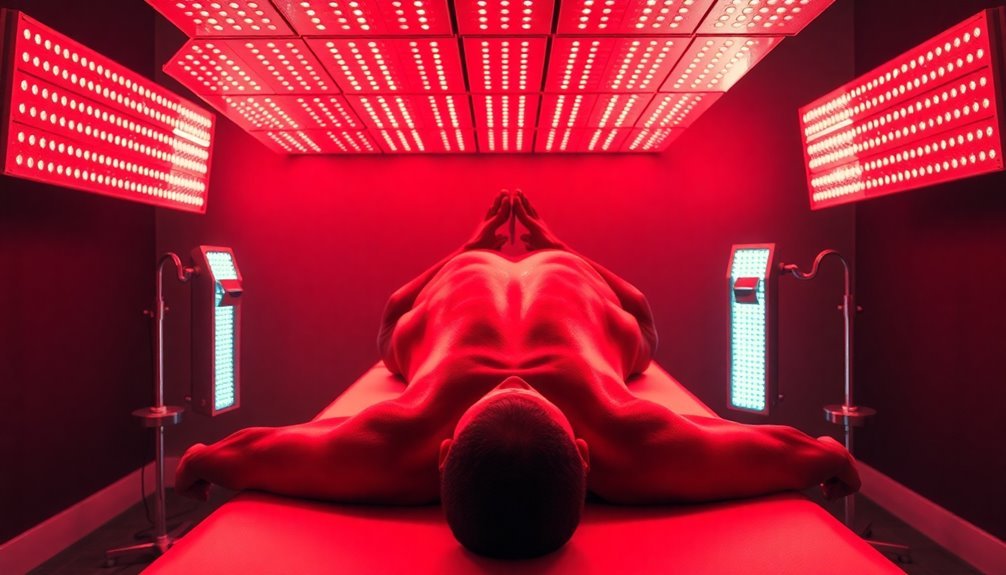
Through recent advances in sports medicine, LED light therapy has emerged as a powerful tool for muscle recovery. This non-invasive treatment uses specific wavelengths of red and near-infrared light to stimulate your muscles at the cellular level, promoting faster healing and reducing post-workout pain. Developed by NASA for plant research in space, LED therapy has proven equally beneficial for human tissue healing.
When you undergo LED light therapy, the light penetrates your tissue and triggers a process called photobiomodulation. Your cells' mitochondria absorb this light, which boosts ATP production and accelerates cellular repair.
You'll find that the wavelengths used typically range from 640 to 950 nanometers, which is considered the therapeutic sweet spot for muscle recovery.
You can access LED therapy through various methods, from professional clinics to at-home devices. Whether you're using it before workouts to prepare your muscles or after exercise to reduce inflammation, you'll need consistent sessions to see results.
The treatment's effectiveness comes from its ability to improve blood circulation, remove metabolic waste products like lactic acid, and enhance overall muscle performance.
You don't need to worry about safety, as LED therapy doesn't use harmful ultraviolet light, making it a reliable option for regular muscle recovery treatment.
Science Behind Muscle Recovery
To understand muscle recovery, you'll need to grasp the complex physiological responses that occur right after exercise. During intense workouts, your muscles experience damage, depleted energy stores, and accumulated metabolic waste products like lactic acid. Your body responds by triggering an inflammatory response, which promotes muscle repair and growth.
Your body relies on three energy systems to recover: the phosphagen system for quick energy bursts, glycolysis for moderate-duration activities, and mitochondrial respiration for endurance. These systems work together to restore your energy balance and remove metabolic by-products through increased blood flow and lymphatic drainage. Red light therapy can enhance this mitochondrial respiration process, leading to more efficient energy production and faster recovery.
Training adaptations play a significant role in improving your recovery capacity. Regular exercise increases your V•O2max, enhances muscle-buffering capacity, and boosts the number of monocarboxylate transporters that help remove lactate from your muscles.
Different training programs target specific aspects of recovery, with high-intensity interval training being particularly effective at improving both V•O2max and buffering capacity. These adaptations help your body become more efficient at handling exercise-induced stress and recovering faster from intense workouts.
Benefits for Athletic Performance
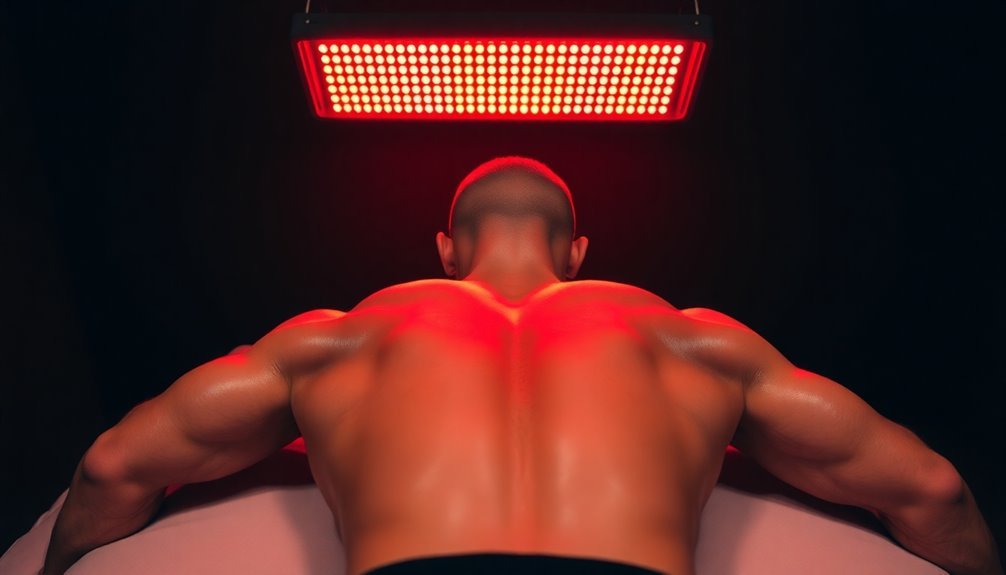
Proper muscle recovery delivers significant advantages for athletes aiming to maximize their performance. When you incorporate LED therapy into your training routine, you'll experience enhanced endurance and improved athletic output through increased blood flow and oxygen delivery to your muscles.
This boost in circulation helps your body maintain peak performance levels for longer periods while reducing fatigue. Your cells can harness the power of nitric oxide production for optimal blood vessel dilation.
You'll notice significant improvements in your strength and power output thanks to enhanced ATP production and optimized mitochondrial function. The therapy's ability to regulate inflammatory responses means you'll spend less time dealing with muscle soreness and more time training effectively.
Your muscles will recover faster as the treatment helps flush out inflammatory compounds and deliver essential nutrients to damaged tissues.
The benefits extend beyond immediate performance gains. You'll experience faster healing between training sessions, reduced delayed onset muscle soreness (DOMS), and improved tissue repair.
This means you can maintain a more consistent training schedule without compromising your body's recovery needs. The enhanced oxygen delivery and nutrient circulation also support your muscles' energy production, helping you achieve better results in both training and competition.
LED Vs Traditional Recovery Methods
Red light therapy stands apart from traditional recovery methods by offering a more efficient and less invasive approach to muscle healing. You'll experience faster recovery times while avoiding the risks and downtimes associated with conventional treatments like surgery. The therapy's ability to boost ATP production directly enhances your body's natural healing processes.
Unlike traditional methods that might require you to pause your training routine, you can immediately return to your daily activities after LED therapy sessions.
- No invasive procedures or lengthy recovery periods required
- Minimal risk of side effects compared to surgical interventions
- Immediate return to normal activities post-treatment
- Enhanced cellular metabolism and oxygen delivery for faster healing
When you choose LED therapy for recovery, you're opting for a solution that works synergistically with your existing fitness routines. The therapy's ability to modulate inflammation and boost metabolism makes it an ideal complement to your exercise and dietary efforts.
You'll benefit from an extensive healing approach that targets multiple aspects of recovery simultaneously. The therapy's excellent safety profile means you won't have to worry about significant side effects or complications that often accompany traditional recovery methods.
If you're looking for a convenient, effective way to speed up your post-workout recovery, LED therapy offers a modern solution that delivers consistent results.
Optimal Treatment Timing
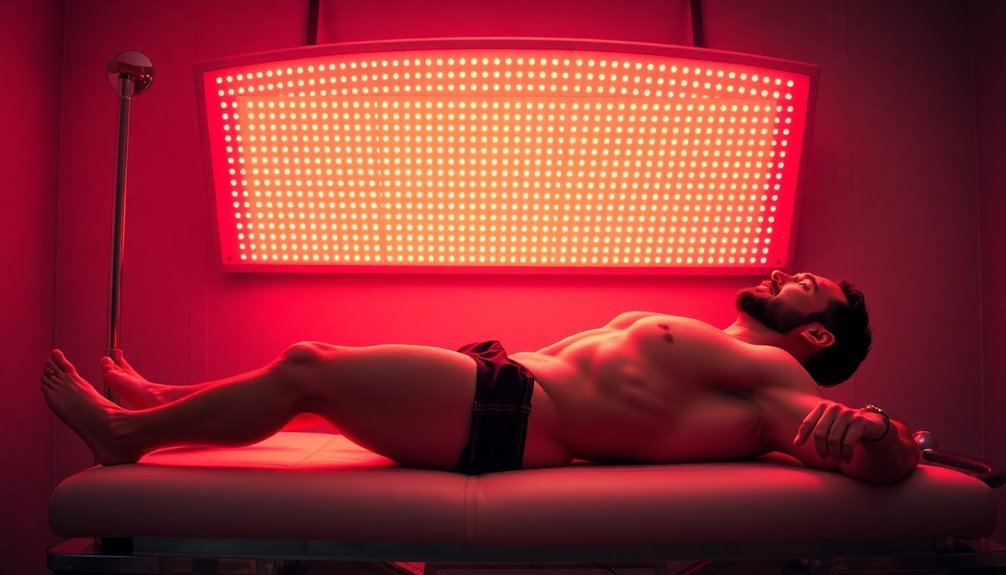
In accordance with scientific research, timing your LED therapy sessions can substantially impact their effectiveness for muscle recovery. To maximize benefits, you'll want to schedule your treatments both before and after workouts, with specific timing depending on your exercise type.
For strength training, apply LED therapy 5-10 minutes before your session. If you're doing endurance or cardio work, you'll benefit from treatment both before and immediately after your workout. For plyometric exercises, using LED therapy on both ends of your workout helps reduce muscle soreness and improve muscle quality.
You'll need to dedicate at least 15 minutes for pre-workout sessions and 10-30 minutes for post-workout recovery. The ideal wavelength should fall between 640-950 nm, with each LED outputting 10-35 mW. For smaller muscles, aim for 20-60 joules, while larger muscle groups need 60-300 joules. The therapy enhances mitochondrial ATP production, leading to improved cellular energy and faster recovery.
Don't rush between treatments; maintain at least a 6-hour gap between sessions. You can adjust your treatment schedule based on your recovery needs, but consistency is key.
Plan for 2-3 sessions per week, and you'll notice reduced muscle soreness and improved recovery times.
Targeting Specific Muscle Groups
To maximize your recovery results, you'll need to understand how to position LED devices correctly for different muscle groups, with larger muscles like quadriceps requiring longer exposure times than smaller muscles like biceps.
You can optimize treatment by placing the LED array perpendicular to the muscle fibers and maintaining consistent contact throughout the session, typically 15-20 minutes for major muscle groups. LED light therapy shows a remarkable 40% improvement in healing musculoskeletal injuries when properly applied.
Different muscle regions have varying recovery needs, with legs often requiring 60-300 joules while smaller arm muscles may only need 20-60 joules for effective treatment.
Major Muscles Treatment Guide
Light therapy's targeted approach offers unique benefits for different muscle groups, allowing you to address post-workout soreness with precision. You'll need to understand how to effectively treat major muscle areas to maximize your recovery results. The treatment provides a warm soothing sensation as you target specific muscles.
For best outcomes, focus on 4-6 treatment sessions per muscle group, using both red and infrared wavelengths to stimulate cellular repair and reduce inflammation.
- Upper body treatment: Position the device directly on shoulders, biceps, triceps, and chest muscles for 10-15 minutes per area.
- Lower body focus: Target quadriceps, hamstrings, and calves individually to guarantee complete coverage.
- Core muscle care: Apply therapy to abdominal muscles and lower back regions to address deep tissue soreness.
- Spot treatment: Zero in on particularly sore areas with concentrated application.
When treating major muscle groups, you'll want to maintain consistent contact between the device and your skin. Since light therapy stimulates mitochondrial function and increases ATP production, you're not just masking pain – you're actively supporting your muscles' recovery process.
This targeted approach helps reduce downtime between workouts while promoting long-term muscle health and top performance.
Best LED Positioning Techniques
Mastering LED positioning techniques can substantially enhance your muscle recovery results. When positioning your LED device, guarantee direct skin contact with the targeted muscle groups, as this maximizes the penetration of therapeutic wavelengths into the tissue.
You'll want to select specific muscles that need attention, such as your quadriceps or hamstrings, and maintain consistent contact throughout the treatment session. For optimal therapeutic effect, apply a total of 120 Joules per thigh, as shown effective in clinical studies.
Keep the device steady at the recommended distance – typically touching your skin – and don't exceed 60 Joules of energy dose for peak effectiveness.
For the best results, you'll need to time your LED therapy sessions strategically. Apply the treatment either 3-6 hours before your workout or immediately after.
If you're targeting large muscle groups, divide the area into sections and treat each portion systematically to guarantee complete coverage.
Remember to adjust the intensity level according to your device's specifications, typically aiming for a power density around 250 mW/cm².
Maintain each position for the recommended duration, usually several minutes per area, before moving to the next muscle group.
Always follow your device's specific guidelines for distance and duration to achieve peak therapeutic benefits.
Recovery Time By Region
Now that you understand proper LED positioning, knowing the specific recovery needs for different muscle groups will help maximize your results. Each region of your body responds differently to LED therapy, requiring specific energy outputs and treatment durations for ideal recovery.
Lower body muscles, like hamstrings and quadriceps, need higher energy outputs (60-300 joules) due to their size, while upper body muscles like biceps and triceps require less (20-60 joules).
Core muscles benefit from red light therapy's anti-inflammatory effects and increased blood flow, making it effective for thorough recovery.
- Lower body treatments substantially reduce DOMS in calf muscles and improve recovery after intense activities like sprinting.
- Upper body recovery shows marked improvement, especially after eccentric exercises, with reduced muscle damage markers.
- Core region benefits from enhanced blood flow and reduced inflammation, though it's less extensively studied.
- Full-body sessions lasting 15 minutes, performed several times weekly, provide thorough recovery benefits.
For the best results, you can apply red light therapy either before or after workouts. This flexibility allows you to adapt the treatment to your specific needs and training schedule while still achieving substantial recovery benefits.
Treatment Protocols and Recommendations
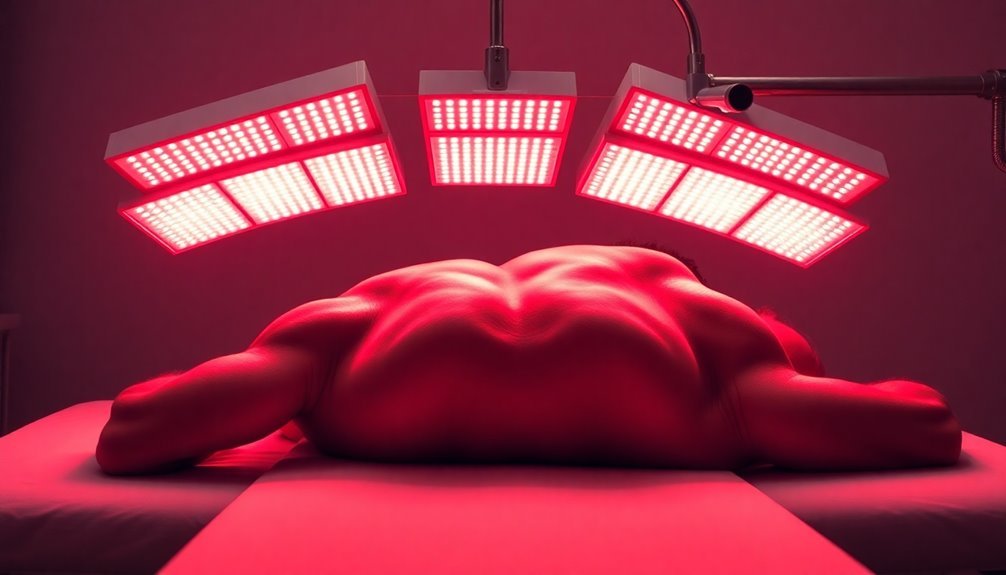
A successful red light therapy treatment plan requires careful attention to timing, wavelength, and application methods. You'll want to aim for wavelengths between 640-950 nm, with 630 nm and 810 nm being particularly effective. For the best results, apply therapy 3-6 hours before your workout, though 5-10 minutes pre-exercise can also be beneficial.
When treating muscles, make sure you're using the right energy dose: 20-60 joules for smaller muscles and 60-300 joules for larger ones. Keep power output between 10-35 mW per LED to avoid excess heat. Remember not to exceed 60 joules, as higher doses might be counterproductive.
| Parameter | Recommendation |
|---|---|
| Session Length | Minimum 15 minutes |
| Frequency | Several times weekly |
| Pre-workout Timing | 3-6 hours before |
| Power Range | 10-35 mW per LED |
| Energy Dose | 20-60J small muscles, 60-300J large muscles |
For endurance activities, you'll benefit from both pre and post-workout treatments. Apply the therapy directly to targeted muscle groups, focusing on areas prone to soreness. This approach is particularly effective for treating specific injuries like sprains and tendonitis, while helping reduce overall muscle damage markers and inflammation.
Choosing the Right Device
With the right treatment protocols in place, selecting an appropriate red light therapy device becomes your next important step. You'll want to focus on devices that emit light between 640-950 nm wavelengths and provide 10-35 mW per LED for ideal muscle recovery.
When treating larger muscle groups, look for devices with generous treatment areas of about 10.5" x 5.75" to guarantee thorough coverage.
Key features to evaluate:
- LED output power of 20-60 joules for small muscles and 60-300 joules for larger muscles
- Combination of red and infrared light capabilities for both surface and deep tissue treatment
- FDA clearance to guarantee safety and effectiveness
- Rechargeable battery options for enhanced portability and convenience
Flexible pads offer versatility for multiple body parts, while wraps and handheld devices work well for specific areas like wrists and ankles.
Choose devices from reputable brands with high customer satisfaction ratings and clinical backing. If you're an athlete, prioritize devices with proven results in reducing return-to-play time and muscle soreness.
Safety and Best Practices
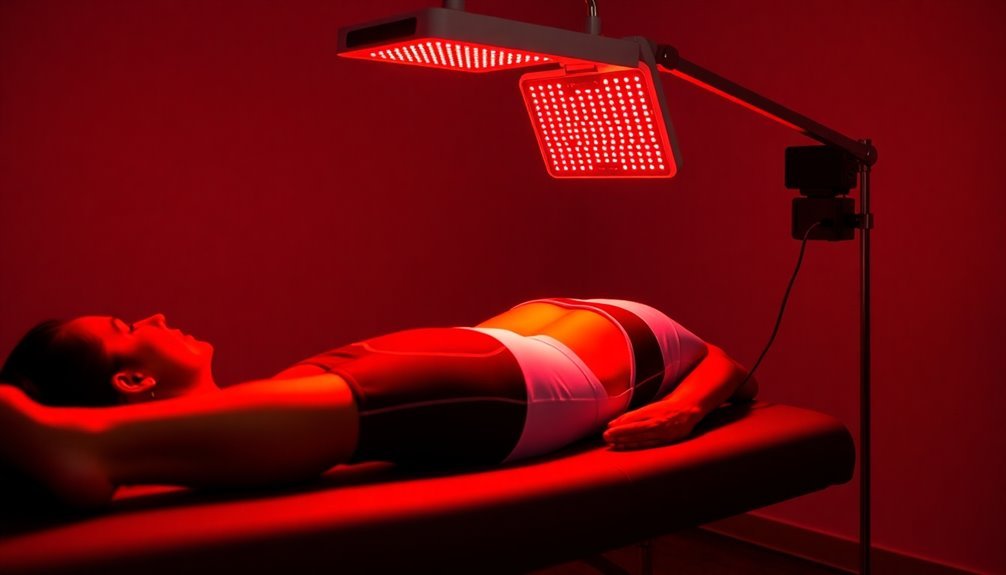
Safety guidelines form the foundation of effective red light therapy treatment. Before starting any treatment regimen, consult your healthcare provider to confirm it's appropriate for your needs.
Choose only FDA-cleared devices that deliver wavelengths between 640-950 nm, and avoid any devices emitting harmful ultraviolet light.
When using red light therapy, limit your sessions to 10-20 minutes, focusing on specific muscle groups you've worked during exercise. For strength training, apply the therapy 5-10 minutes before your workout. If you're doing endurance or cardio exercises, use it both before and after your session.
Keep the device at a safe distance according to manufacturer guidelines, and confirm it doesn't become hot during use.
Stay well-hydrated to maximize the therapy's benefits, and combine it with other recovery methods like stretching.
Monitor your skin's response and discontinue use if you experience any adverse reactions.
For the best results, maintain a consistent treatment schedule of several sessions per week, adjusting the dosage based on muscle size – 20-60 joules for smaller muscles and 60-300 joules for larger muscle groups.
Frequently Asked Questions
Can LED Therapy Help With Chronic Conditions Like Fibromyalgia?
Yes, LED therapy can help manage your fibromyalgia symptoms by reducing pain and inflammation, boosting cellular healing, and increasing endorphin production. You'll likely experience improved muscle function and better quality of life.
How Long Does One LED Therapy Session Typically Last?
You'll typically spend 5-30 minutes in an LED therapy session. If you're using a handheld device, expect 5-10 minutes, while full-body panels require 15-30 minutes. Start with shorter sessions as a beginner.
Is It Safe to Use LED Therapy While Taking Medications?
You shouldn't use LED therapy while taking certain medications, especially photosensitizing drugs like antibiotics, retinoids, or NSAIDs. Always consult your doctor and check medication labels before starting LED therapy sessions.
Can Children or Elderly People Safely Undergo LED Therapy?
While LED therapy is generally safe for elderly people, you'll need extra caution with children, especially for eye treatments. Make sure you consult a doctor first and follow safety guidelines for both age groups.
Does Skin Tone or Thickness Affect LED Therapy Effectiveness?
Yes, your skin tone and thickness affect LED therapy results. You'll need higher energy doses for darker or thicker skin since both factors reduce light penetration and may impact the treatment's effectiveness.
In Summary
LED light therapy offers you a cutting-edge solution for post-workout recovery. You'll find it's a non-invasive, effective way to reduce muscle soreness and speed up healing. By following proper protocols and using the right device, you can maximize your training results and minimize downtime. Whether you're a professional athlete or weekend warrior, incorporating LED therapy into your recovery routine will help you bounce back faster and perform better.

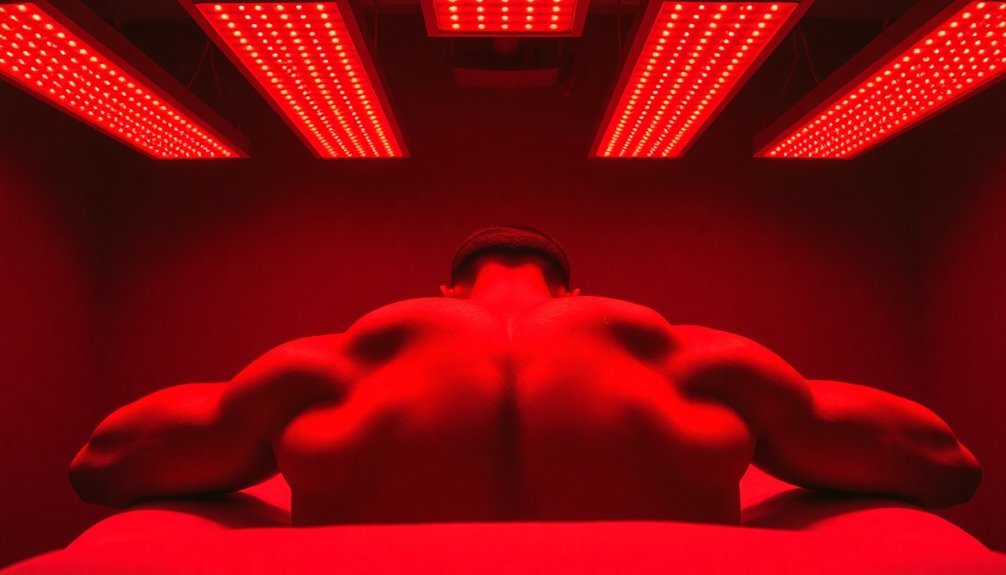



Leave a Reply